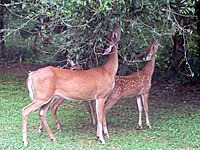
Photo from wikipedia
Summary 1.Tropical forest loss can drive the extinction of forest-dependent species. Yet, non-forest species can proliferate in deforested landscapes, thus enabling community-level attributes (e.g., total abundance and richness) to be… Click to show full abstract
Summary 1.Tropical forest loss can drive the extinction of forest-dependent species. Yet, non-forest species can proliferate in deforested landscapes, thus enabling community-level attributes (e.g., total abundance and richness) to be maintained in the remaining forest patches. Such compensatory dynamics have been, however, poorly investigated regarding the phylogenetic dimension of species diversity. Here, we assessed whether compensatory dynamics can stabilize the phylogenetic richness, divergence and structure of bird communities in response to forest loss in two regions in the Brazilian Atlantic forest, each under with different levels of land use intensification. 2.We surveyed birds in 40 forest sites, and assessed the response of five phylogenetic metrics to forest cover measured in local (600-m radius) landscapes. We separately assessed the entire community, forest-dependent and non-forest-dependent species and used information-theoretic criteria to assess the effect of forest cover on each response variable. In particular, we evaluated the plausibility of four models: a null model (no effect of forest cover), a linear model, a power law model (nonlinear effect), and an analysis of covariance model (to assess whether the effect of forest cover differed between regions). 3.Forest cover varied from 7% to 98%, and was positively related to the phylogenetic richness of forest-dependent species, but negatively related to the phylogenetic richness and divergence of non-forest birds, particularly in the more disturbed region. As consequence, the phylogenetic richness and divergence of the entire community were weakly related to forest cover. 4.Forest birds were less phylogenetically clustered in sites surrounded by lower forest cover, but the phylogenetic structure of non-forest birds was independent of forest cover. 5.Synthesis and applications. The phylogenetic impoverishment of forest-dependent birds is offset by the phylogenetic enrichment and divergence of non-forest-dependent birds in severely tropical deforested landscapes. These compensatory dynamics suggest that both bird groups are important for safeguarding bird evolutionary diversity in human-modified landscapes. Although deforested landscapes are reservoirs of bird phylogenetic diversity, suggesting that ecosystem functioning may be maintained in these sites, preventing further deforestation is urgently needed to preserve forest birds and their key ecological roles in the ecosystem. This article is protected by copyright. All rights reserved.
Journal Title: Journal of Applied Ecology
Year Published: 2018
Link to full text (if available)
Share on Social Media: Sign Up to like & get
recommendations!